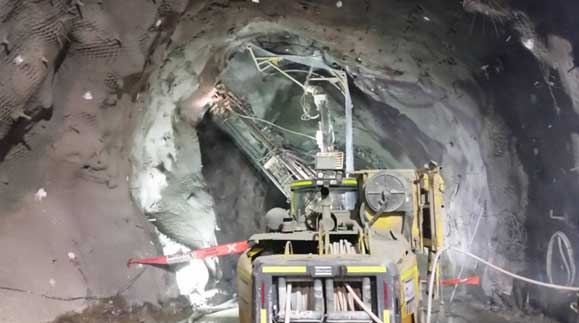Academic activities offered by the Chamber of Mines of Peru aim at zero-accident management. |

For the Chamber of Mines of Peru, safety training is a fundamental part of proper exploration work. As it is well known, mining is a high-risk activity, especially in underground operations, which are the most complex and most exposed operations for workers. Over the last 15 years, rock falls have become one of the main causes of mining accidents. This is due to the alterations produced in the bedrock as a consequence of geological and environmental factors or the high pressures on the exposed ground during mining, as well as bad practices of workers when carrying out their work. This has caused the Chamber of Mines of Peru to intensify the development of training programs aimed to the prevention and control of rock fall to contribute to the reduction of resulting accidents in extractive projects. |
Causes of Mining Accidents |
The human factor has become one of the main causes of mining accidents. Thus, we can mention the bad practice of workers, due to lack of knowledge or overconfidence. This occurs especially when operators accumulate a lot of experience in developing their work, which causes them to overlook some basic safety steps. For example, they carry out a visual and therefore surface assessment of the risk area, performing tasks such as watering the faces or just scaling those rocks that at first sight are loose. Another possibility of risk arises when, after inspecting and assessing the work area, it is decided to carry out a simple rock scaling in those areas where support is required. Another risky behavior occurs when personnel do not take into account the recommendations established in the Written Safe Work Procedures (PETS). A clear example is when personnel position themselves on the line of possible rock falls, when they use inadequate tools such as very short crowbars, or when they work on improvised surfaces. To illustrate this, we can mention what happened one year ago in a deposit in Peru. An operator scaled rocks without following the safety recommendations. In other words, he carried it out from the work front, rather than from a defensive position. This resulted in a rock crashing into his leg, causing an exposed fracture. |
Recommendations to avoid Accidents in Surface Mining |
To avoid these situations, the Chamber of Mines of Peru has intensified the level of training, so that workers develop their work correctly. As George Falen Sánchez said, «rock fall is the present danger in underground mining. For this reason, we must constantly scale and inspect, trying to use our crowbars and other tools in good condition.” To prevent and reduce a possible rock fall as much as possible, it is necessary to inspect the work area in order to identify those elements that warn us of a possible rock fall, such as displacement of wedges, fractures, faults and breaks on the ground, the deviation of floors or gallery walls, the deformation or breakage of bolts and timbers, strange noises, and the observation of new rocks on the work floor. It is recommended that rock scaling be carried out in the place where blasting has been developed. The area that will be established as work front, and those areas, where personnel will transit, should be marked. This was shared by Andrés Ruiz, worker at Codelco’s El Teniente Mining Operation, «It is important to avoid the exposure or transit of workers in those critical areas that require the application of support methods.» It must be kept in mind that the behavior of the bedrock is unpredictable. Rocks can remain loose for a period of time, as well as weaken at any time. Therefore, it will be the obligation of all workers to constantly observe and inspect the conditions of the operation where the personnel transit and to proceed to scale them, in case there are loose slabs. It is also important that workers know that this task must be carried out at all times. |
How to avoid cave-ins in the exploration area? |
Despite planning, safety measures and technological advances, the possibility of a landslide is always latent. To illustrate the danger, we can take the recent case in Mexico, where a coal deposit collapsed in the state of Sonora. The disaster caused the death of two miners and one more was injured. One of the main measures to reduce accidents is the implementation of various elements for the support of the site. The objective is to maintain an optimum level of safety and to structure passages with sufficient dimensions for the circulation of personnel, equipment, air, etc. Among the main techniques or elements that can be used to reinforce stability, we have timbering, as well as anchor bolts, steel mesh, shotcrete and steel frames. The analysis of the conditions present in the deposit will allow deciding the most suitable type of support to carry out the mining project in the safest way. In this field, innovation is constant and in recent years, there has been an increase in the use of structural synthetic fiber as reinforcement for shotcrete, due to the added value it has compared to metallic structures. |
It is also important that mining companies keep all their work personnel constantly trained in the tools to be used, in addition to the correct signage and lighting of the spaces.